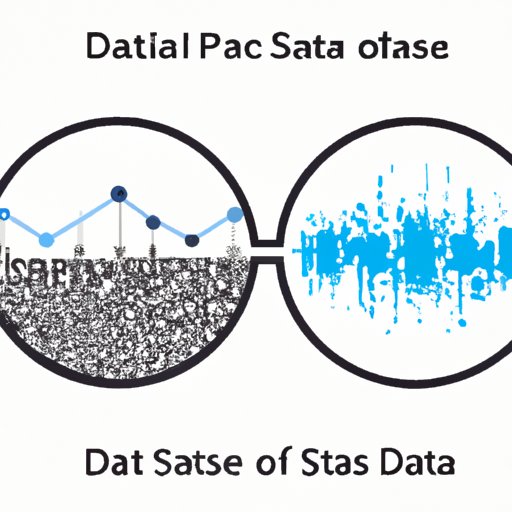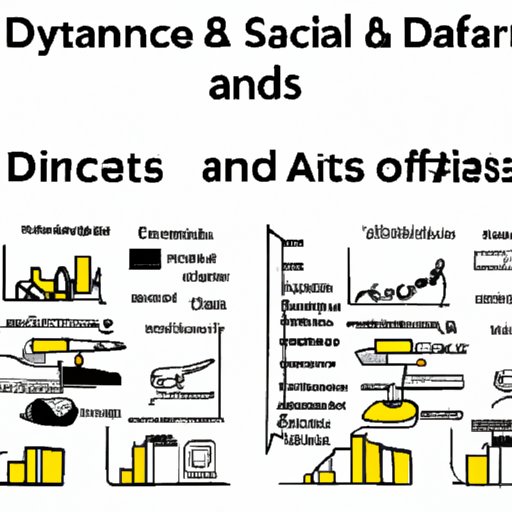Introduction
Data science and data analytics are two related but distinct fields that are often used interchangeably. While the terms are sometimes used as synonyms, there are important differences between the two disciplines. This article explores these differences and examines the similarities and differences between data science and data analytics, the benefits of each approach, and how they can be used together to gain insights from big data.

Comparing and Contrasting Data Science and Data Analytics
Data science and data analytics are both concerned with extracting knowledge from large amounts of data. However, there are key differences between the two disciplines. Data science is a broader field that encompasses data analysis, machine learning, predictive modeling, and other related disciplines. Data analytics, on the other hand, is focused primarily on analyzing existing data sets and using them to draw conclusions about the underlying trends and patterns in the data.
Both data science and data analytics involve the use of data-driven methods to draw insights from data. However, data science has a more holistic approach to data analysis, while data analytics is more focused on extracting specific insights from existing data sets. Data science also focuses more on predictive models and machine learning, while data analytics is more focused on analyzing data to uncover trends and patterns.
Exploring the Benefits of Both Data Science and Data Analytics
Data science and data analytics can both be valuable tools for businesses looking to gain insights from their data. Data science can help businesses develop predictive models to anticipate future trends and events, while data analytics can help businesses uncover hidden patterns in their data. Both approaches can provide valuable insights into customer behavior and market trends, allowing businesses to make better decisions and improve their operations.
Benefits of Data Science
Data science can provide businesses with powerful predictive models that can be used to anticipate customer behavior, market trends, and other future events. These models can provide invaluable insights into customer needs and preferences, allowing businesses to tailor their offerings to meet those needs. Data science can also be used to develop automated systems that can detect anomalies or outliers in data sets, alerting businesses to potential issues before they become costly problems.
Benefits of Data Analytics
Data analytics can provide businesses with valuable insights into customer behavior and market trends. By analyzing existing data sets, businesses can identify patterns and correlations that can be used to inform decisions and strategies. Data analytics can also be used to uncover new opportunities, such as identifying target markets or developing new products and services. Finally, data analytics can help businesses track the performance of their products and services, allowing them to adjust their strategies accordingly.

Examining the Pros and Cons of Each Approach
Data science and data analytics both have their advantages and disadvantages. While data science can provide powerful predictive models, it is also more complex and expensive than data analytics. Data analytics, on the other hand, is less complex and can provide valuable insights into customer behavior and market trends, but it is limited by the data sets it has access to.
Pros of Data Science
- More comprehensive approach to data analysis
- Can develop predictive models to anticipate future events
- Can detect anomalies or outliers in data sets
Cons of Data Science
- More complex and expensive than data analytics
- Requires specialized knowledge and skills
- Results are not always reliable
Pros of Data Analytics
- Less complex and expensive than data science
- Can uncover patterns and correlations in data sets
- Can identify new opportunities
Cons of Data Analytics
- Limited by available data sets
- Results are not always reliable
- Can be time consuming and labor intensive

How Data Science and Data Analytics Complement Each Other
Data science and data analytics are complementary disciplines that can be used together to gain insights from big data. By combining the power of predictive modeling with the insights provided by data analytics, businesses can gain a more complete picture of their customers, markets, and operations. This can help them make better decisions and maximize their profits.
For example, a business might use data science to create a predictive model to forecast customer demand for a particular product. This model can then be used in conjunction with data analytics to analyze customer behavior and identify potential opportunities. This combination of data science and data analytics can be used to inform marketing decisions, optimize pricing strategies, and develop new products and services.
Analyzing the Different Types of Data Science and Data Analytics
Data science and data analytics come in many different forms. Data science can include machine learning, predictive modeling, natural language processing, and other related disciplines. Data analytics, on the other hand, can involve descriptive analytics, predictive analytics, and prescriptive analytics.
Types of Data Science
- Machine Learning
- Predictive Modeling
- Natural Language Processing
- Computer Vision
Types of Data Analytics
- Descriptive Analytics
- Predictive Analytics
- Prescriptive Analytics
Understanding the Role of Data Science and Data Analytics in Business Decisions
Data science and data analytics can be powerful tools for businesses looking to make better decisions and maximize their profits. By leveraging the insights provided by data science and data analytics, businesses can gain a more complete understanding of their customers, markets, and operations. This can help them identify new opportunities, optimize their strategies, and make informed decisions.
Benefits to Businesses Utilizing Data Science and Data Analytics
- Identify new opportunities
- Optimize strategies
- Make informed decisions
- Improve customer experience
- Gain competitive advantage
Examples of Businesses Leveraging Data Science and Data Analytics
- Retailers using predictive models to anticipate customer demand
- Financial institutions using data analytics to identify fraud
- Manufacturers using data science to optimize production processes
- Marketing teams using data analytics to target customers
Conclusion
Data science and data analytics are two distinct but related disciplines that can be used together to gain insights from big data. While data science is focused on developing predictive models, data analytics is focused on uncovering patterns and correlations in existing data sets. Both approaches can provide valuable insights into customer behavior and market trends, allowing businesses to make better decisions and improve their operations.
This article has explored the similarities and differences between data science and data analytics, the benefits of each approach, and how they can be used together to gain insights from big data. It has also examined the types of data science and data analytics and how they can be used to inform business decisions. Finally, it has discussed the role of data science and data analytics in business decisions and highlighted some examples of businesses leveraging these approaches.
In conclusion, data science and data analytics are complementary disciplines that can be used together to gain insights from big data. By leveraging the power of predictive modeling and the insights provided by data analytics, businesses can gain a more complete understanding of their customers, markets, and operations, allowing them to make better decisions and maximize their profits.
(Note: Is this article not meeting your expectations? Do you have knowledge or insights to share? Unlock new opportunities and expand your reach by joining our authors team. Click Registration to join us and share your expertise with our readers.)
